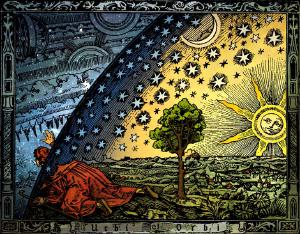Post
Star Light,
Star Bright
7 May 2013
 Camille Flammarion
Camille FlammarionThe Sun is a star like many others. It is special to us because it provides Earth with light and heat, but on a cosmic scale our Sun is an average, rather smallish star. How we came to understand this fact is a story with origins in the ancient past.
For the earliest astronomers, the sky contained three things: the Sun, the Moon, and the stars. The Sun and Moon were great disks of light which could be used to predict the seasons, but the stars were tiny points of light in the velvet expanse of night. Most ancient cultures noticed that five stars appeared to move relative to the vast expanse of stars. The Latin name for these “wandering stars” was asteres planetai, from which we get the name planets. These five planets - Mercury, Venus, Mars, Jupiter and Saturn - were seen as special stars, and together with the Sun and Moon, they were seen to affect everything from the cycle of the seasons to the nature of your personality.
This study of the positions of the Sun, Moon and planets is known as astrology. Out of early astrology our modern astronomy developed. The ancient Greeks saw the stars as being fixed within a celestial sphere which marked the edge of the universe. The Earth rested at the center of this universe, while the Sun, Moon and planets moved around the Earth on their own cosmic spheres.
In Medieval Europe, this view of the universe was integrated into the theology of the Catholic Church. Earth became the center of God’s creation, and heaven lay beyond the celestial sphere of stars. Perhaps the stars were even holes in the night sky, through which the light of heaven could shine. This idea of the stars did not significantly change until 1543, when Nicolaus Copernicus proposed his heliocentric model of the universe.
Copernicus thought that the Sun, rather than the Earth, was the center of the universe. Copernicus knew that his proposal was deeply radical. It moved Earth from the center of God’s creation and declared that it was simply another planet. He only published his ideas when he reached the end of his life, fearing condemnation from the Church.
Perhaps the strongest early supporter of Copernicus’ model was Giordano Bruno. Bruno was not only a strong supporter of heliocentrism, but also he took the idea further than Copernicus dared. If the Earth was merely a planet among many, then perhaps the Sun was merely a star like those in the night sky. If that were true, then the stars should have countless planets spinning around them just as we orbit the Sun, and perhaps those distant planets are worlds like Earth, with life and people living on them. Bruno’s ideas were not popular, and this was one of the reasons he was condemned as a heretic.
Soon after, Galileo demonstrated that the Earth really did move around the Sun. Like Bruno, he felt the stars were distant suns, and he argued that brighter stars must therefore be closer than dimmer stars. Then in the late 1600s Christiaan Huygens compared the brightness of the Sun with the brightness of the star Sirius and calculated that Sirius was about 28,000 times further away than the Sun, or about half a light year away. This result wasn’t very accurate largely because Huygens assumed Sirius was like the Sun, when in fact it is much larger and brighter.
By the end of the 17th century the view that stars were suns began to gain popularity. Today we know that stars come in a variety of ages and sizes. We can observe features of many stars and have even discovered planets around distant stars. Perhaps in time we will discover an Earth-like planet with its own life and prove that Bruno was right after all.